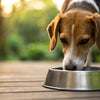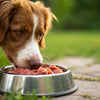How Much Raw Food Should You Feed Your Dog? A Comprehensive Guide for Pet Owners
- Houndsy
Table of Contents
- Introduction
- Understanding the Raw Food Diet
- Factors Influencing How Much Raw Food to Feed Your Dog
- How to Transition Your Dog to a Raw Food Diet
- Utilizing Feeding Guidelines
- Common Misconceptions About Raw Feeding
- Conclusion
Introduction
Have you ever observed your dog scavenging through the house looking for scraps or how gleefully they devour their meals? These behaviors can speak volumes about their diet! As pet owners, we strive to provide our furry friends with the best nutrition possible. But when it comes to feeding practices, particularly with raw food diets, many pet parents find themselves at a crossroads. How much raw food should you feed your dog, and what factors truly influence this decision?
As we venture into the realm of raw dog feeding, we’ll equip you with insights that cut through the confusion. According to recent surveys, over 30% of dog owners are now considering or actively feeding a raw diet, noting benefits such as improved coat health, higher energy levels, and fewer gastrointestinal issues. With such an increase in popularity, it's essential to understand the logistics behind raw feeding—ensuring your pet gets the right nutrition without overwhelming yourself in the process.
By the end of this blog post, you will not only understand how much raw food your dog should consume but also gain insights into the benefits of a raw food diet and practical feeding tips. We’ll explore guidelines based on age, weight, activity level, and lifestyle, making sense of it all. And we’ll also look at how Houndsy’s flagship product, the Houndsy Kibble Dispenser, can enhance the feeding routine for you and your dog.
Let’s dive into the specifics, so you can confidently nurture your furry friend’s health through a properly managed raw food diet!
Understanding the Raw Food Diet
What Is a Raw Food Diet for Dogs?
The raw food diet, often referred to as "BARF" (biologically appropriate raw food), focuses on feeding dogs a diet composed of raw meat, bones, fruits, and vegetables. Advocates of this diet argue that it mimics the natural eating habits of dogs' wild ancestors, which thrived on fresh, uncooked foods. A raw diet typically includes:
- Meat (muscle and organ)
- Bones (edible bones or ground)
- Fruits and Vegetables (those safe for canines)
- Supplements (if needed, to ensure nutritional balance)
This diet intends to provide high protein levels, essential fatty acids, and complete nutrition tailored to your dog's dietary needs. With proper planning and understanding, feeding raw can not only be a healthy choice but also a more engaging and exciting one for your pet.
Benefits of Feeding Raw
- Improved Digestion: Many dogs experience fewer gastrointestinal issues when consuming a raw diet, leading to firm stools and less frequent bathroom breaks.
- Enhanced Coat Quality: Owners frequently report shinier coats and healthier skin when switching to raw, likely due to the omega fatty acids found in this type of diet.
- Higher Energy Levels: Raw-fed dogs often display increased vitality and better stamina, especially important for active breeds.
- Better Dental Health: Chewing on raw bones can help to naturally clean dogs’ teeth, reducing plaque buildup and promoting healthier gums.
While the benefits can be significant, it’s crucial to carefully consider how much raw food you should be feeding your dog to reap these rewards without any adverse effects.
Factors Influencing How Much Raw Food to Feed Your Dog
Ideal Body Weight
The primary determinant of how much raw food you should feed your dog hinges upon their ideal body weight. The general recommendation for adult dogs is to feed them 2-3% of their body weight, while puppies typically thrive on 4-6%.
To illustrate:
- A 50 lb dog (ideal weight) would require 1–1.5 lbs of raw food each day.
- A 25 lb dog would approximately need 0.5–0.75 lbs.
- Conversely, a 10 lb dog may be fed around 0.2–0.3 lbs daily.
It's vital that you adjust these amounts based on your dog’s individual circumstances, like activity level and metabolism.
Activity Level
Your dog’s activity level will significantly affect their nutritional requirements. Active dogs burn more calories and may require a higher percentage of their body weight in raw food, while more sedentary dogs should be fed at the lower end of the spectrum.
For instance, a highly active 75 lb dog may need to be fed about 3-3.5 lbs of raw food daily, while a sedentary dog of the same weight may need only 2-3 lbs.
Age and Life Stage
Puppies have different nutritional requirements than adult dogs. As mentioned earlier, puppies should be fed 4-6% of their current weight because they require more energy for growth and development.
Conversely, senior dogs may require less food due to decreased activity levels and metabolic rate. Regularly monitor weight and body condition to ensure you’re feeding your dog appropriately as they age.
Breed Considerations
Certain breeds have predispositions toward unique dietary needs. Larger breeds may need a slower growth rate to avoid joint issues, especially during puppyhood. Therefore, consult with your veterinarian to determine specific amounts based on breed and size.
How to Transition Your Dog to a Raw Food Diet
Transitioning to a raw food diet requires thoughtful planning. Here’s a step-by-step process to ensure a smooth transition:
-
Consult Your Veterinarian: Before making a significant dietary change, it's crucial to discuss your plans with a veterinarian, particularly if your dog has existing health concerns.
-
Gradual Introduction: Start by mixing a small amount of raw food with their regular diet to help your dog adjust. This approach prevents gastrointestinal upset.
-
Monitor Health: Pay attention to your dog’s behavior and health during the transition. Look out for any adverse reactions such as vomiting or diarrhea.
-
Adjust Portions Accordingly: As your dog adjusts to raw food, monitor their weight and overall health, gradually optimizing amounts based on the conditions discussed earlier.
-
Supplementation: Depending on your dog’s individual needs, consider consulting with a vet about necessary supplements to ensure balanced nutrition.
Utilizing Feeding Guidelines
The Percentage-Based Approach
To determine how much raw food to feed your dog, we can use the percentage-based approach:
- For Adult Dogs: Feed about 2-3% of their healthy body weight daily.
- For Puppies: Start with 4-6% of current body weight until around six months of age.
Calculating this will help set a baseline for how much raw food to provide:
Example:
- For a 50 lb dog:
- At 2%: 50 x 0.02 = 1 lb/day
- At 3%: 50 x 0.03 = 1.5 lb/day
This baseline can help you identify where to begin, but always tailor it according to your dog’s needs!
Common Misconceptions About Raw Feeding
- Raw Diet Is Unbalanced: While some are concerned about nutritional deficiencies, balanced raw feeding ensures your dog receives varied protein sources, with several owners successfully feeding raw diets for years.
- Raw Diet Is Dangerous: While bacteria can be present in raw meats, the risk of illness is substantially mitigated through good hygiene practices and safe handling.
By acknowledging and addressing these misconceptions through education and consultation with veterinarians, we can all make informed choices about our pets' diets.
Conclusion
In confirming how much raw food to feed your dog, it is essential to consider various factors like ideal body weight, age, activity level, and breed. Feeding a raw diet can provide numerous health benefits when approached thoughtfully and deliberately. With the right planning and information, you can simplify mealtime while ensuring your furry friend receives the nutrition they deserve.
Incorporating our Houndsy Kibble Dispenser into your feeding routine can enhance your raw feeding experience, offering precision portioning and convenience without any mess. You’ll not only provide your pet with excellent nutrition but also make the feeding ritual a stylish and enjoyable part of your day!
FAQs
How often should I feed my dog a raw diet? It's generally recommended to feed adult dogs once or twice daily, while puppies may require three to four meals throughout the day.
What types of raw food are safe for dogs? Most raw meats (beef, chicken, turkey) are safe, along with freshly prepared fruits and vegetables. Just avoid foods toxic to dogs, such as grapes and chocolate.
Can I mix raw food with dry kibble? While it is possible, it’s best to transition gradually to raw to avoid digestive upset. Mixing raw with kibble can lead to potential digestive issues, so separate feeding times might be more advisable.
How can I ensure my dog is getting enough nutrients on a raw food diet? Consult with a veterinarian to create a balanced diet plan and consider incorporating supplements as needed to ensure comprehensive nutrition.
Transitioning to a raw diet and determining the right quantities can feel daunting, but with the right approach, you’re well on your way to providing your dog with the best diet possible!












